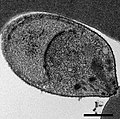Plasmodium knowlesi
Plasmodium knowlesi[edit]
Plasmodium knowlesi is a species of malaria parasite that primarily infects macaque monkeys. It is also known to infect humans, causing a severe form of malaria known as knowlesi malaria. This species was first identified in 1931 by Robert Knowles and Biraj Mohan Das Gupta in a long-tailed macaque in Malaysia.
Taxonomy[edit]
Plasmodium knowlesi belongs to the genus Plasmodium, which includes various species of malaria parasites. It is classified under the subgenus Plasmodium (Plasmodium) and the family Plasmodiidae. The species name "knowlesi" is derived from the name of the scientist who first discovered it, Robert Knowles.
Life Cycle[edit]
The life cycle of Plasmodium knowlesi involves both humans and macaque monkeys. The parasite is transmitted through the bite of infected Anopheles mosquitoes. When an infected mosquito bites a human or a macaque, the parasite enters the bloodstream and travels to the liver. In the liver, the parasite multiplies and forms merozoites, which are released into the bloodstream. These merozoites invade red blood cells, where they continue to multiply and cause the characteristic symptoms of malaria.
Symptoms and Diagnosis[edit]
Knowlesi malaria caused by Plasmodium knowlesi can lead to severe illness and even death if not treated promptly. The symptoms of knowlesi malaria are similar to those of other types of malaria and include fever, chills, headache, muscle aches, and fatigue. Diagnosis is typically done through microscopic examination of blood samples, where the presence of Plasmodium knowlesi can be detected.
Distribution[edit]
Plasmodium knowlesi is primarily found in Southeast Asia, particularly in Malaysia, Thailand, the Philippines, and Indonesia. However, cases of knowlesi malaria have also been reported in other parts of the world, including India and some countries in Africa. The increasing number of cases outside of Southeast Asia has raised concerns about the potential global spread of this parasite.
Prevention and Treatment[edit]
Preventing knowlesi malaria involves taking measures to avoid mosquito bites, such as using insect repellents, wearing protective clothing, and sleeping under mosquito nets. In areas where knowlesi malaria is prevalent, efforts are also made to control mosquito populations through insecticide spraying and environmental management.
The treatment of knowlesi malaria typically involves the use of antimalarial drugs, such as chloroquine or artemisinin-based combination therapies (ACTs). Prompt diagnosis and treatment are crucial to prevent complications and reduce the risk of severe illness or death.
Research and Future Directions[edit]
Research on Plasmodium knowlesi is ongoing to better understand its transmission dynamics, pathogenesis, and drug resistance patterns. Efforts are also being made to develop new diagnostic tools and effective vaccines against knowlesi malaria. Understanding the biology and epidemiology of this parasite is essential for implementing effective control strategies and reducing the burden of knowlesi malaria.
See Also[edit]
References[edit]
<references />
-
Plasmodium knowlesi blood smears showing intraerythrocytic developmental cycle
-
Life cycle of Plasmodium species
-
Plasmodium knowlesi merozoite
-
Plasmodium knowlesi blood smears
-
Photograph of Robert Knowles
Ad. Transform your life with W8MD's Budget GLP-1 injections from $75


W8MD offers a medical weight loss program to lose weight in Philadelphia. Our physician-supervised medical weight loss provides:
- Weight loss injections in NYC (generic and brand names):
- Zepbound / Mounjaro, Wegovy / Ozempic, Saxenda
- Most insurances accepted or discounted self-pay rates. We will obtain insurance prior authorizations if needed.
- Generic GLP1 weight loss injections from $75 for the starting dose.
- Also offer prescription weight loss medications including Phentermine, Qsymia, Diethylpropion, Contrave etc.
NYC weight loss doctor appointmentsNYC weight loss doctor appointments
Start your NYC weight loss journey today at our NYC medical weight loss and Philadelphia medical weight loss clinics.
- Call 718-946-5500 to lose weight in NYC or for medical weight loss in Philadelphia 215-676-2334.
- Tags:NYC medical weight loss, Philadelphia lose weight Zepbound NYC, Budget GLP1 weight loss injections, Wegovy Philadelphia, Wegovy NYC, Philadelphia medical weight loss, Brookly weight loss and Wegovy NYC
|
WikiMD's Wellness Encyclopedia |
| Let Food Be Thy Medicine Medicine Thy Food - Hippocrates |
Medical Disclaimer: WikiMD is not a substitute for professional medical advice. The information on WikiMD is provided as an information resource only, may be incorrect, outdated or misleading, and is not to be used or relied on for any diagnostic or treatment purposes. Please consult your health care provider before making any healthcare decisions or for guidance about a specific medical condition. WikiMD expressly disclaims responsibility, and shall have no liability, for any damages, loss, injury, or liability whatsoever suffered as a result of your reliance on the information contained in this site. By visiting this site you agree to the foregoing terms and conditions, which may from time to time be changed or supplemented by WikiMD. If you do not agree to the foregoing terms and conditions, you should not enter or use this site. See full disclaimer.
Credits:Most images are courtesy of Wikimedia commons, and templates, categories Wikipedia, licensed under CC BY SA or similar.
Translate this page: - East Asian
中文,
日本,
한국어,
South Asian
हिन्दी,
தமிழ்,
తెలుగు,
Urdu,
ಕನ್ನಡ,
Southeast Asian
Indonesian,
Vietnamese,
Thai,
မြန်မာဘာသာ,
বাংলা
European
español,
Deutsch,
français,
Greek,
português do Brasil,
polski,
română,
русский,
Nederlands,
norsk,
svenska,
suomi,
Italian
Middle Eastern & African
عربى,
Turkish,
Persian,
Hebrew,
Afrikaans,
isiZulu,
Kiswahili,
Other
Bulgarian,
Hungarian,
Czech,
Swedish,
മലയാളം,
मराठी,
ਪੰਜਾਬੀ,
ગુજરાતી,
Portuguese,
Ukrainian




